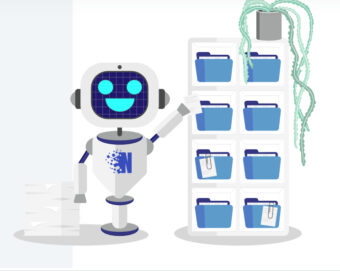This Week in Imaging: How AI Is Being Used in Document Workflows

If there’s one law that we should have for artificial intelligence (AI), it should be that it’s used to do the most mundane, boring tasks, and leave the creative (fun) tasks for us humans. In the office, AI should be devoted to the everyday tasks, freeing humans to create new innovations and technology – with an occasional assist from AI when needed.
That sounds like a tall order, but actually one area where AI is most suitable is taking over time-consuming document workflows in the office. And, we’ve actually been using some of these AI tools for many, such as optical character recognition software for converting scanned documents into PDFs. More recently, Xerox with the Xerox Translate and Print App, users can scan a document with a Xerox Connect Key MFP and then specify that it be translated and printed in another language.
Some examples of AI used in document-workflow solutions include:
- Microsoft Azure Form Recognizer: Extracts text, key-value pairs, and tables from documents.
- Google Document AI: Analyzes and processes documents, extracting data and insights.
- Adobe Document Cloud: Offers AI-driven features for document editing, signing, and collaboration..
Here’s how AI is integrated into different stages of document workflows:
Document Creation
- Content Generation: AI tools can generate text for reports, summaries, and articles based on user inputs or predefined templates.
- Grammar and Style Checking: AI-powered tools like Grammarly provide real-time grammar, spelling, and style suggestions.
- Template Creation: AI can help create standardized templates for various document types, ensuring consistency across an organization.
Document Processing
- OCR technology converts scanned documents, PDFs, and images into editable and searchable text.
- Data Extraction: AI can automatically extract relevant data from documents such as invoices, contracts, and forms, reducing manual data entry.
- Text Classification: AI algorithms classify documents into categories, such as invoices, contracts, or emails, based on their content, enabling automated sorting and routing.
Document Management
- Automated Filing and Tagging: AI can automatically tag and file documents based on their content, making it easier to organize and retrieve them later.
- Version Control: AI tracks document versions and changes, ensuring that users always access the most up-to-date information.
- Access Control: AI can manage and enforce document-access policies, ensuring that only authorized personnel can view or edit certain documents.
Document Review and Analysis
- Content Analysis: AI can analyze document content to identify key themes, trends, and insights.
- Compliance Checking: AI systems can check documents against compliance standards and regulations, identifying potential issues.
- Sentiment Analysis: AI tools can analyze the tone and sentiment of documents, such as customer feedback or employee surveys.
Document Editing and Collaboration
- Real-time Collaboration: AI facilitates real-time collaboration by allowing multiple users to work on a document simultaneously while tracking changes and suggestions.
- Content Suggestions: AI can suggest content additions or modifications based on the document’s context and purpose.
- Language Translation: AI-powered translation tools can translate documents into multiple languages.
Document Storage and Retrieval
- Smart Search: AI enhances search functionality by understanding context and intent, making it easier to find relevant documents quickly.
- Document Indexing: AI automates the indexing of documents based on their content, improving search accuracy and retrieval times.
- Archiving and Retention: AI can manage document archiving and retention schedules, ensuring that documents are stored or deleted according to compliance requirements.
Document Security
- Anomaly Detection: AI can detect unusual activity related to document access or modification, identifying potential security breaches.
- Encryption and Authentication: AI can manage document encryption and user authentication processes, ensuring secure document handling.
- Data Masking: AI can mask sensitive information in documents, protecting privacy while allowing document use for analysis or sharing.
Document Workflow Automation
- Process Automation: AI can automate routine tasks such as document approval workflows, email responses, and data entry.
- Workflow Optimization: AI analyzes document workflows to identify bottlenecks and inefficiencies, suggesting improvements to streamline processes.
- Integration with Other Systems: AI can integrate document workflows with other business systems, such as enterprise resource planning (ERP) or customer relationship management (CRM) systems.
Advanced Analytics and Reporting
- Predictive Analytics: AI can analyze past document data to predict future trends and outcomes, helping in decision-making processes.
- Dashboard and Reporting: AI generates interactive dashboards and reports based on document data, providing visual insights and facilitating data-driven decisions.
- KPI Monitoring: AI tracks key performance indicators (KPIs) related to document workflows, providing real-time updates and alerts.
This Week in Imaging
Workflow Solutions
Zoom Launches No-Code Workflow Automation Solution
Lexmark Gets Recognition for Cloud Printing Services
Market Research and Reports
Global PC Market Continues Recovery
3D Printing
3D-Printing Leaders Nano Dimension and Desktop Metal to Merge
Imaging Supplies
Katun Opens New Asia HQ, Announces New CEO
Other News
Yes, HP Has Discontinued HP+ for LaserJets

You must be logged in to post a comment.